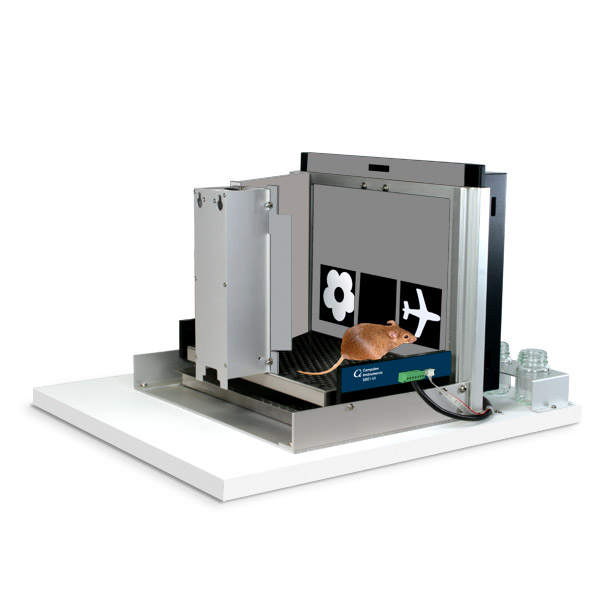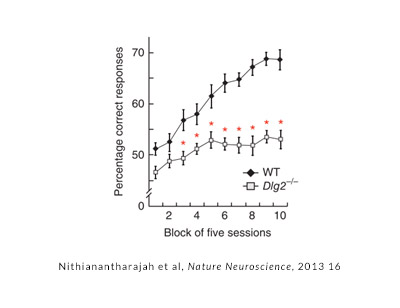
In humans a similar task has proved to be highly effective for the early detection of Alzheimer's disease (AD). A 1995 study using volunteers who thought they had memory issues [named the questionable dementia (QD) group] found that CANTAB PAL could discriminate who had AD at an early stage.
Fowler KS, Saling MM, Conway EL, Semple JS and Louis WJ (1995) Computerised delayed matching-to-sample and paired associate performance in the early detection of dementia. Applied Neuropsychology, 2, 72-78.

The graph shows individual subject results The 34 error cut-off (shown by red line) would have discriminated at the 6-month point who in the QD group would go on to receive AD diagnoses and who would not.
The translational potential of the paradigm can be seen by comparing human and mice DLG2 mutation studies. CANTAB PAL with people with DLG2 mutations produced a similar phenotypic profile to that observed by using the rodent PAL task with Dlg2-knockout mice.

In the PAL task for rodents, subjects learn and remember which of three objects goes in which of three spatial locations. On a given trial, two different objects are presented; one in its correct location; the other in an incorrect location. The subject must choose which stimulus is in the correct location. The task has been shown to be sensitive to cholinergic transmission and to hippocampal dysfunction and can dissociate glutamate from acetylcholine receptor function in the hippocampus.
Smith, S. M., Zequeira, S., Ravi, M., Johnson, S. A., Hampton, A. M., Ross, A. M., Pyon, W., Maurer, A. P., Bizon, J. L., & Burke, S. N. (2022). Age-related impairments on the touchscreen paired associates learning (PAL) task in male rats. Neurobiology of Aging, 109, 176?191. - Abstract
Shepherd, A., Zhang, T., Hoffmann, L. B., Zeleznikow-Johnston, A. M., Churilov, L., Hannan, A. J., & Burrows, E. L. (2021). A Preclinical Model of Computerized Cognitive Training: Touchscreen Cognitive Testing Enhances Cognition and Hippocampal Cellular Plasticity in Wildtype and Alzheimer?s Disease Mice. Frontiers in Behavioral Neuroscience, 15(December), 1?15. - Abstract
Palmer, D., Dumont, J. R., Dexter, T. D., Prado, M. A. M., Finger, E., Bussey, T. J., & Saksida, L. M. (2021). Touchscreen cognitive testing: Cross-species translation and co-clinical trials in neurodegenerative and neuropsychiatric disease. In Neurobiology of Learning and Memory (Vol. 182, p. 107443). - Abstract
Whoolery CW, Yun S, Reynolds RP, et al. (2020) Multi-domain cognitive assessment of male mice shows space radiation is not harmful to high-level cognition and actually improves pattern separation. Sci Rep.;10(1):2737.
Luo, J., Tan, J., & Nithianantharajah, J. (2020). Associative Learning and Motivation Differentially Requires Neuroligin-1 at Excitatory Synapses. BioRxiv, 2020.01.01.890798. - Abstract
Tamming, R., Dumeaux, V., Langlois, L., Ellegood, J., Qiu, L., Jiang, Y., Lerch, J. P., & B?rub?, N. G. (2019). Atrx Deletion in Neurons Leads to Sexually-Dimorphic Dysregulation of miR-137 and Spatial Learning and Memory Deficits. SSRN Electronic Journal. - Abstract
Braeckman, K., Descamps, B., Vanhove, C., & Caeyenberghs, K. (2019). Exploratory relationships between cognitive improvements and training induced plasticity in hippocampus and cingulum in a rat model of mild traumatic brain injury: a diffusion MRI study. Brain Imaging and Behavior. - Abstract
Braeckman, K., Descamps, B., Caeyenberghs, K., & Vanhove, C. (2018). Longitudinal DTI changes following cognitive training therapy in a mild traumatic brain injury rat model. Frontiers in Neuroscience, 12. - Abstract
Kim J, Wasserman EA, Castro L, Freeman JH. (2016) Anterior cingulate cortex inactivation impairs rodent visual selective attention and prospective memory. Behav Neurosci.; 130(1):75-90.
Delotterie D, Mathis C, Cassel JC, Dorner-Ciossek C, Marti A. (2014) Optimization of touchscreen-based behavioral paradigms in mice: implications for building a battery of tasks taxing learning and memory functions. PLoS One.; 9(6):e100817.
Talpos JC, Aerts N, Fellini L, Steckler T. (2014) A touch-screen based paired-associates learning (PAL) task for the rat may provide a translatable pharmacological model of human cognitive impairment. Pharmacol Biochem Behav.; 122:97-106. - Abstract
Nithianantharajah J, Komiyama NH, McKechanie A, et al. (2013) Synaptic scaffold evolution generated components of vertebrate cognitive complexity. Nat Neurosci.; 16(1):16-24.
Coba MP, Komiyama NH, Nithianantharajah J, et al. (2012) TNiK is required for postsynaptic and nuclear signalling pathways and cognitive function. J Neurosci.; 32(40):13987-13999.
Bartko SJ, Vendrell I, Saksida LM, Bussey TJ. (2011) A computer-automated touchscreen paired-associates learning (PAL) task for mice: impairments following administration of scopolamine or dicyclomine and improvements following donepezil. Psychopharmacology (Berl).; 214(2):537-548
Talpos JC, Winters BD, Dias R, Saksida LM, Bussey TJ. (2009)A novel touchscreen-automated paired-associate learning (PAL) task sensitive to pharmacological manipulation of the hippocampus: a translational rodent model of cognitive impairments in neurodegenerative disease. Psychopharmacology (Berl).;205(1):157-168. - Abstract
Clelland CD, Choi M, Romberg C, et al. (2009) A functional role for adult hippocampal neurogenesis in spatial pattern separation. Science.; 325(5937):210-213.
Second Generation Bussey Chamber developed for mice with Intelli-interface supports up to 20 chambers on one PC. On the strength of 10 years of feedback and development, the system is even more flexible and with more features.
Adapted for rats, this is a hippocampal task. In humans, this task has proved to be highly effective for the early detection of Alzheimer's disease.

